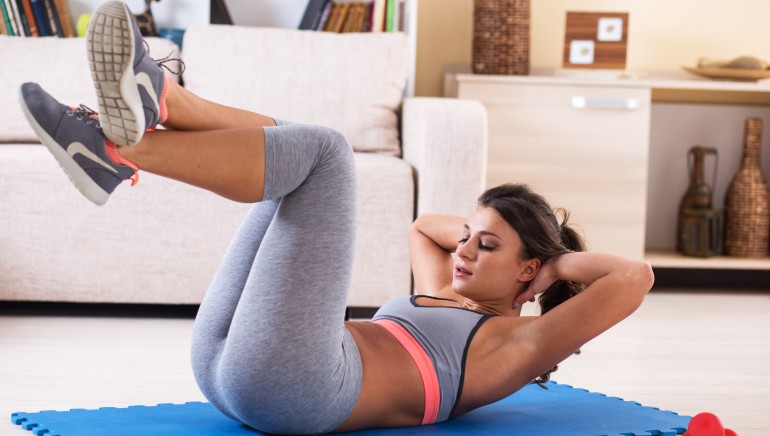Sit-ups are great for your core muscles and posture. So, perform this exercise regularly in a correct manner to enjoy the benefits of sit-ups.
Sit-ups may seem like a basic and simple exercise. After all, to do this classic exercise, you just have to lie on your back with your knees bent and feet flat on the floor, raise your torso towards your knees then lower yourself back down. But it is an effective bodyweight exercise, as it focuses on strengthening the core muscles, particularly the rectus abdominis, which is the muscle group associated with the “six-pack”. When you do sit-ups, the abdominal muscles clearly get targeted. The exercise also engages other muscles too, and so can be beneficial for you. The benefits of sit-ups are many, so start doing them regularly.
What are the health benefits of sit-ups?
Here are some of the reasons why you should do sit-ups every day!
1. Sit-ups strengthens core muscles
People who do sit-ups witness a significant increase in their abdominal muscle’s activation, according to a 2016 research published in the Journal of Physical Therapy Science. “This exercise targets the rectus abdominis along with obliques, and lower back muscles, which are essential for core stability,” says fitness expert Shikha Singh.

2. Improve posture
Sit-ups can strengthen the muscles in your abdomen, lower back, and pelvis. These muscles are essential to help maintain proper alignment of the spine. Once the alignment is correct, it will improve your posture.
3. Enhance flexibility
Sit-ups involve a range of motion that stretches the spine and hip flexors. This motion can increase flexibility in the spine, hips, and legs, which is beneficial for overall mobility and can reduce stiffness in the body.
4. Boost muscular endurance
Abdominal exercise training, including sit-ups, can improve muscular endurance, as per research published in the Journal of Strength and Conditioning Research in 2011. This endurance is crucial for sustaining physical activity over time, improving performance in sports, and handling prolonged physical tasks without fatigue.
5. Support balance and stability
A strong core, developed through sit-ups, improves balance and stability. These are critical for performing dynamic movements, preventing falls, and maintaining coordination in various activities, from sports to everyday movements.
6. Promote injury prevention
“If you have a strong core, it can support your hips as well as knees,” says the expert. This way, it makes them less susceptible to injury during any physical activity. But you can end up with lower back or neck injuries if you don’t do sit-ups in the right way.
7. Sit-ups support weight loss
Sit-ups alone are not a high-calorie-burning exercise that will reduce belly fat, but they do contribute to muscle building. “Increased muscle mass can help fire up metabolism, which plays a key role in a person’s weight-loss journey,” says Singh.
8. Enhance athletic performance
A strong core, developed through exercises like sit-ups, is crucial for athletic performance. It helps transfer energy efficiently between the upper and lower body, improving power, speed, and endurance in sports like running, swimming, and weightlifting.

How to do sit-ups?
Sit-ups and crunches may look similar, but they are not the same. So, if you want to do sit-ups, follow these steps:
- Lie on your back on any flat surface, but you should feel comfortable.
- Bend your knees with your feet flat on the floor and hip-width apart.
- You can either place your hands behind your head or just near your chest; whichever feels comfortable. Whatever you choose, try not to put any pressure on your neck.
- Engage your core muscles (abs, lower back and glutes) by drawing your naval to your tailbone.
- Once the core is engaged, lift your upper body.
- Slowly go back to the first step.
“You should try to do 10 to 15 reps for three to four sets at least two or three times in a week, and if done consistently, it will gradually make your core strong,” says the expert.
Variations of sit-ups
The basic movement remains the same, but a few variations can be added to make it more fun and challenging.
1. Weighted sit-ups
- Extra weights in the form of dumbbells or plates can be used.
- Hold the weight near your chest or overhead, and then lift your upper body.
2. Declined sit-ups
- Lie down on the decline side of the bench and fix your feet in the pad of the bench.
- As you engage your core, lift your upper body.
3. V-sit-ups
- Lie down on your back with arms overhead and straight legs.
- Now engage your core by drawing naval to the tailbone, lift your upper body and legs simultaneously, bringing your toes towards your hands making a ‘V’ shape, and then slowly go down.
4. Full sit-ups
- Lie down flat on your back with feet hip-width apart with arms extended overhead.
- Now lift your upper body and tap on your toes, and then slowly go back.
5. Jack knife sit-ups
- Lie flat on your back with arms overhead and legs straight.
- Lift both arms and legs simultaneously, bring toes towards hands, and then slowly go back down.
Who should avoid doing sit-ups ?
Sit-ups may look easy, but they are not for everyone. Here are people who should not do sit-ups –
- People with lower back pain or any injury must not do this, as it can aggravate the conditions. A sit-up is a spine flexion movement that puts a strain on your spine and if it is already injured, doing sit-ups can worsen it.
- Not for pregnant women, as there is already a lot of stress and load on the lower back, and doing sit-ups can be a disaster.
- People tend to strain their neck doing sit-ups, so individuals who have any neck pain should avoid this exercise.
Sit-ups can help to attain a strong core, improve posture and aid in weigh loss. These benefits make sit-ups a valuable addition to a well-rounded fitness routine. But do it properly to avoid injuries.





